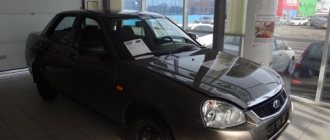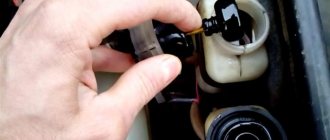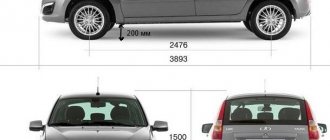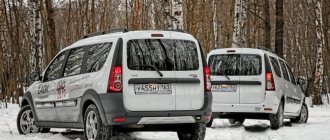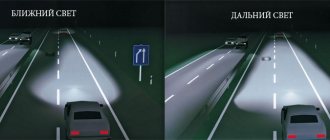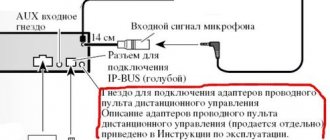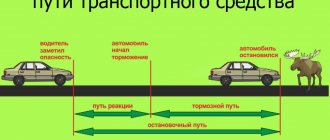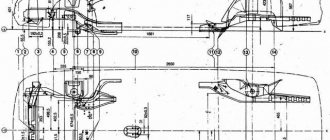| Essence: Road sign 3.2 Traffic prohibited prohibits the movement of all vehicles except route and postal vehicles. But, with exceptions. Traffic regulations allow you to drive to your home, place of work or service. Links to sources and paragraphs of the Traffic Regulations 2015, Code of Administrative Offenses: Traffic Rules of the Russian Federation, Appendix 1, Section 3 Prohibitory road signs Text of the Traffic Regulations 2015: Prohibitory road sign 3.2 Traffic is prohibited in Appendix 1 to the Traffic Regulations |
Traffic regulations P1 3.2
Prohibiting road sign 3.2 Prohibited traffic prohibits the movement of relevant types of vehicles in both directions.
The prohibition sign does not apply
The effect of the prohibitory sign 3.2 Traffic prohibited does not apply to route vehicles.
The effect of the prohibitory sign 3.2 Traffic is prohibited does not apply to vehicles of federal postal service organizations that have a white diagonal stripe on a blue background on the side surface, and vehicles that serve enterprises located in the designated area, and also serve citizens or belong to citizens living or working in the designated area. In these cases, vehicles must enter and exit the designated area at the intersection closest to their destination.
The effect of the prohibition sign 3.2 Traffic is prohibited does not apply to vehicles driven by disabled people of groups I and II, to vehicles transporting such disabled people or disabled children.
“No Parking” sign: features, coverage areas
This pointer only affects the side on which it is installed. You are allowed to stop:
- a taxi with the meter on, waiting for a passenger;
- postal vehicles equipped with a white stripe on a blue background;
- a vehicle driven by disabled people of the first and second groups (if there is a sign “Disabled person driving”);
- cars that transport disabled people, including children;
- transport of organizations and commercial enterprises in the absence of other parking space.
- drawing a broken yellow line on the edge of the road - the prohibition ceases to apply at the point where the marking ends;
- installation of signs indicating the distance to the end of the restriction or the type of transport that is not allowed to stand;
- drawing one or two white vertical lines on the index.
Two lanes – no stopping on even days. If there are 2 signs on both sides of the road, standing is allowed from 19.00 to 21.00 on the left side of the roadway.
All signs intended for installation with this prohibitory sign are divided into 2 groups. The first includes white rectangles with an arrow(s). If the arrow is directed upward and supplemented with a number, then the sign’s coverage area ends through the distance indicated by the number. The downward arrow indicates the end point of the ban.
The second group of signs are white rectangles depicting one group of vehicles: tractors, trucks, buses, minibuses, motorcycles. The ban applies only to the group visible in the image.
- before the next intersection;
- at a sign indicating the beginning or end of a populated area;
- at the sign “End of all restrictions” (this is a white circle crossed out with black stripes).
If the coverage area needs to be extended, another sign is installed.
If stopping for a long time is caused by an accident, congestion or breakdown, this is not considered a violation if there is an alarm or warning sign. The vehicle can be left on the side of the road if it cannot move on its own. Another condition is to exclude the possibility of theft.
The importance of knowing road signs cannot be underestimated, since they provide the driver with comprehensive information related to road traffic.
These information images indicate what is prohibited, what is allowed on a given section of the road, inform and warn the driver about the danger.
They are divided into nine groups:
- Warning. As the name suggests, the purpose of these types is to inform about dangers on a section of the road in order for the driver to take appropriate measures to ensure the safety of themselves, passengers and pedestrians.
- Priority signs. Indicate to drivers the order of passage through narrow road sections and intersections.
- Prohibiting. Appropriate traffic restrictions are introduced and also lifted.
- Prescriptive. Establish mandatory driving conditions on a lane or section of road.
- Special instructions. Designed to organize a certain traffic mode, or cancel it.
- Additional Information. These are signs used in conjunction with other types, complementing or clarifying the actions of the latter.
- Information types.
- Identification varieties.
- Service.
Below we will look in detail at the “No Parking” type, which is classified as prohibiting, so first we will take a closer look at this broad group.
Outwardly, it is very simple to distinguish them - a circle with a red border on a white or blue background, which is quite difficult not to notice. This is a very large group that regulates literally all aspects of road traffic, starting from the maximum permissible speed, restrictions on the weight and types of vehicles, and ending with the ban on entry, parking and stopping of cars on various sections of the road.
It is important not only to confidently imagine what prohibitory signs look like and what exactly they prohibit, but also to understand exactly on which sections of the roadway they operate, that is, to imagine the area of effect of the sign. Let's first figure out where the zone of action of the prohibiting species begins.
Here, unlike warning types, everything is very simple - the ban begins to operate immediately after the place where the image is installed, and it does not matter what exactly it means - the maximum permissible speed or a parking ban.
Of course, there are exceptions to any rule. So, for example, the “Parking is prohibited” type, established at the entrance to the yard, does not apply to persons living in the house or working in an organization located here, if a detour is not provided. There are other exceptions related to the action of this sign, which will be discussed below.
This road symbol can be found very often - a blue circle with a red border, crossed diagonally by one red stripe. It is clear that it prohibits parking of vehicles on any day of the week.
But sometimes you can find it prohibiting parking, for example, only on odd days, or even days - on them one or two white stripes (vertical) are drawn inside a crossed out circle. Accordingly, one lane is crossed out - you cannot park a car only on odd days, two - on even days.
However, there are restrictions here too - the ban is valid only until the evening - until 19.00, so in order not to break the rules, before 21.00 the vehicle must be driven to the other side of the road - as a rule, a sign with a reverse restriction is installed on it.
Well, in the period from 19.00 to 21.00 you can park your car in the coverage area of any sign - you will not break the rules. It should also be noted that there are categories of people who can safely ignore the “Parking Prohibited” symbol.
We will not describe in detail the rules for federal postal vehicles, for which this type does not apply - this is not relevant for us. It is much more important that cars of disabled people of groups I and II and persons transporting such disabled people can park under this graphic element without fear.
This type, so to speak, is closely related to the road sign we described above. The fact is that where stopping is prohibited, parking is also prohibited, but not vice versa.
You can stop in a “No Parking” zone and you won’t be fined. Let's take a brief look at how a parking lot differs from a stop.
There are no difficulties here, since this issue is covered in some detail in the traffic rules. Understanding the differences between parking and stopping is very simple.
But if at the same time you perform actions related to boarding/disembarking passengers, loading/unloading a car, then regardless of how much time it takes you, you will make a stop, not a parking lot, even if it lasts at least 15 minutes, at least a whole hour.
Externally, “Parking and stopping is prohibited” is very similar to the prohibitory type we described above, only it is no longer one diagonal red stripe on a blue background, but two intersecting stripes.
It also applies only to its own lane. Exceptions to which this symbol does not apply include only route vehicles. Please note that disabled people in their vehicles can no longer stop in the coverage area of this element, unless, of course, a corresponding information sign is installed under it.
In general, its coverage area is the same as that of other prohibitory images, that is, from the installation site to the first intersection, or to the end of the populated area, if no other symbols are installed that remove the restriction.
However, there are nuances:
- Firstly, the zone can be defined by a yellow broken marking line at the edge of the roadway: as long as it is there, parking is prohibited, and with the end of this line, the sign’s coverage area ends.
- Secondly, at the beginning of the article it was not for nothing that we briefly mentioned other road types, in particular, signs used in conjunction with other types to clarify the action of the latter.
Thus, the coverage area signs (vertical arrows on a white rectangle), located under the sign, precisely determine its coverage area.
Thus, if under the graphic element “Parking Prohibited” you see an arrow pointing down, this means the end of the sign’s coverage area - it will be possible to leave a vehicle behind it, unless, of course, other traffic rules are violated.
If the sign indicates an arrow pointing upward, this means that the coverage area will begin from the location where the sign is installed, but you can also usually see a number indicating the length of the coverage area in meters.
The direction of movement to which the sign applies is also important.
At the same time, remember also about the “Parking Restricted Zone” view, which is a large white rectangle with a “No Parking” sign drawn inside it - it already applies to the entire roadway.
The parking ban is also canceled by the “End of all restrictions zone” pictogram - a white circle with black stripes crossing it out. By the way, there is a similar sign for the above-mentioned “Parking Restriction Zone”.
The Code of Administrative Offenses states that ignoring requirements of this type provides for a fine of 1,500 rubles. And if the offense was committed in Moscow or St. Petersburg, then the fine will already amount to 3,000 rubles.
In addition, the car can easily be sent to a penalty area. In order to receive a fine for illegal stopping or parking, by the way, it is not at all necessary to stop in the area covered by the relevant signs.
Road sign 3.2 No Entry is not as strict as sign 3.1 No Entry or Brick
Road sign 3.2 No traffic has a white friendly background and a noticeable red border, and in certain cases allows movement under this sign. Obviously, the developers of the sign showed a great sense of humor by strictly calling the sign “No movement” , as if any movement is prohibited and you need to freeze in place when you see the sign, but at the same time, in the traffic rules, they themselves allowed a whole circle of drivers to enter the sign’s coverage area from the nearest intersection.
And, on the contrary, a sign similar in name, which is called only 3.1 Entry is prohibited or Brick, according to the traffic rules, does not allow any movement in its direction to anyone, except for route transport, even disabled people or residents of nearby houses. And, such a violation of traffic rules may result in the deprivation of a driver’s license. Therefore, the background of the sign 3.1 Brick is completely red, it even merges with the red rim of the prohibitory signs. The brick is depicted on the sign in white. Obviously, this is a sand-lime brick, and not an orange one made from baked clay, because the orange color would be less noticeable against a red background.
Now, you better remember what signs 3.1 and 3.2 are called, what they look like, how they differ, which one is stricter, although they are both good.
Back to section
Warning signs
Warning signs inform drivers that they are approaching a dangerous section of the road, driving along which requires taking measures appropriate to the situation.
1.1 "Railway crossing with barrier."
1.2 “Railway crossing without a barrier.”
1.3.1 "Single track railway"
1.3.2 "Multi-track railway"
Designation of a railway crossing not equipped with a barrier: 1.3.1 - with one track, 1.3.2 - with two tracks or more.
1.4.1-1.4.6 “Approaching a railway crossing.”
Additional warning about approaching a railway crossing outside of populated areas
1.5 “Intersection with tram line”
1.6 “Intersection of equivalent roads”
1.7 "Roundabout"
1.8 “Traffic light regulation”
An intersection, pedestrian crossing or section of road where traffic is regulated by a traffic light.
1.9 "Drawbridge".
Drawbridge or ferry crossing.
1.10 “Departure to the embankment.”
Departure to the embankment or shore.
1.11.1, 1.11.2 “Dangerous turn.”
Rounding a road with a small radius or with limited visibility: 1.11.1 - to the right, 1.11.2 to the left.
1.12.1, 1.12.2 “Dangerous turns”.
A section of the road with dangerous turns: 11.12.1 - with the first turn to the right, 1.12.2 - with the first turn to the left.
1.13 “Steep descent.”
1.14 “Steep climb.”
1.15 "Slippery road."
A section of road with increased slipperiness of the roadway.
1.16 "Rough Road"
A section of road that has unevenness on the roadway (undulations, potholes, uneven junctions with bridges, etc.).
1.17 “Artificial hump”.
A section of road with artificial hump(s) to force a reduction in speed.
1.18 "Gravel release".
A section of road where gravel, crushed stone and the like can be thrown out from under the wheels of vehicles.
1.19 "Dangerous roadside."
A section of road where pulling off to the side of the road is dangerous.
1.20.1-1.20.3 “Narrowing of the road.”
Tapering on both sides - 1.20.1, on the right - 1.20.2, on the left - 1.20.3.
1.21 “Two-way traffic”.
The beginning of a section of road (roadway) with oncoming traffic.
1.22 “Pedestrian crossing”.
Pedestrian crossing marked with signs 5.19.1, 5.19.2 and (or) markings 1.14.1 and 1.14.2.
1.23 "Children".
A section of road near a children's institution (school, health camp, etc.), on the roadway of which children may appear.
1.24 “Intersection with a bicycle path or bicycle pedestrian path.”
1.25 “Road works”.
1.26 “Cattle Driving.”
1.27 "Wild Animals".
1.28 “Falling Stones.”
A section of road where avalanches, landslides, and falling rocks are possible.
1.29 "Sidewind".
1.30 "Low-flying planes."
1.31 "Tunnel".
A tunnel in which there is no artificial lighting, or a tunnel in which the visibility of the entrance portal is limited.
1.32 "Congestion".
A section of road where there is a traffic jam.
1.33 "Other hazards."
A section of road that contains hazards that are not indicated by other warning signs.
1.34.1, 1.34.2 “Rotation direction”.
Direction of movement on a curved road of small radius with limited visibility. Direction to bypass the road section being repaired.
1.34.3 "Rotation direction".
Driving directions at a T-junction or fork in the road. Directions to bypass the road section being repaired.
1.35 “Intersection section.”
1.35. “Crossroads area.” Designation of the approach to an intersection, the section of which is marked with marking 1.26 and which is prohibited from entering if a traffic jam has formed ahead along the route, which will force the driver to stop, creating an obstacle to the movement of vehicles in the transverse direction, with the exception of turning right or left in the cases established by these Rules. Sign 1.35 is installed at the border of the intersection. If at complex intersections it is impossible to install a road sign at the intersection boundary, it is installed at a distance of no more than 30 meters from the intersection boundary.
Warning signs 1.1, 1.2, 1.5-1.33 outside populated areas are installed at a distance of 150-300 m, in populated areas at a distance of 50-100 m before the start of the dangerous section. If necessary, signs can be installed at a different distance, which in this case is indicated on plate 8.1.1.
Signs 1.13 and 1.14 can be installed without plate 8.1.1 immediately before the start of a descent or ascent, if the descents and ascents follow one another.
Sign 1.25 when carrying out short-term work on the roadway can be installed without sign 8.1.1 at a distance of 10-15 m from the work site.
Sign 1.32 is used as a temporary sign or in signs with a variable image before an intersection, from where it is possible to bypass a section of the road where a traffic jam has formed.
Outside populated areas, signs 1.1, 1.2, 1.9, 1.10, 1.23 and 1.25 are repeated. The second sign is installed at a distance of at least 50 m before the start of the dangerous section. Signs 1.23 and 1.25 are also repeated in populated areas immediately at the beginning of the dangerous section.
Prohibition signs
Prohibition signs introduce or remove certain traffic restrictions.
3.1 “Entry is prohibited.”
Entry of all vehicles in this direction is prohibited.
3.2 “Movement is prohibited.”
All vehicles are prohibited.
3.3 “The movement of motor vehicles is prohibited.”
3.4 “Truck traffic is prohibited.”
The movement of trucks and vehicle combinations with a permissible maximum weight of more than 3.5 tons (if the weight is not indicated on the sign) or with a permissible maximum weight more than indicated on the sign, as well as tractors and self-propelled vehicles is prohibited.
Sign 3.4 does not prohibit the movement of trucks intended for the transport of people, vehicles of federal postal organizations having a white diagonal stripe on the side surface on a blue background, as well as trucks without a trailer with a permissible maximum weight of not more than 26 tons that serve enterprises located in the designated area. In these cases, vehicles must enter and exit the designated area at the intersection closest to their destination.
3.5 “Motorcycles are prohibited.”
3.6 “Movement of tractors is prohibited.”
The movement of tractors and self-propelled vehicles is prohibited.
3.7 “Moving with a trailer is prohibited.”
It is prohibited to drive trucks and tractors with trailers of any type, as well as tow motor vehicles.
3.8 “The movement of horse-drawn carts is prohibited.”
The movement of horse-drawn carts (sleighs), riding and pack animals, as well as the passage of livestock is prohibited.
3.9 “Bicycles are prohibited.”
Bicycles and mopeds are prohibited.
3.10 “Pedestrian traffic is prohibited.”
3.11 “Weight limitation”.
The movement of vehicles, including combinations of vehicles, the total actual weight of which is greater than that indicated on the sign, is prohibited.
3.12 “Limitation of mass per vehicle axle.”
It is prohibited to drive vehicles whose actual weight on any axle exceeds that indicated on the sign.
3.13 "Height limitation".
The movement of vehicles whose overall height (with or without cargo) is greater than that indicated on the sign is prohibited.
3.14 "Width limitation".
It is prohibited to drive vehicles whose overall width (laden or unladen) is greater than that indicated on the sign.
3.15 "Length limitation".
The movement of vehicles (vehicle trains) whose overall length (with or without cargo) is greater than that indicated on the sign is prohibited.
3.16 “Minimum distance limitation.”
It is prohibited to drive vehicles with a distance between them less than that indicated on the sign.
3.17.1 “Customs”.
It is prohibited to travel without stopping at a customs office (checkpoint).
3.17.2 "Danger".
The further movement of all vehicles without exception is prohibited due to a traffic accident, accident, fire or other danger.
3.17.3 "Control".
Driving through checkpoints without stopping is prohibited.
3.18.1 “Right turns are prohibited.”
3.18.2 “Left turns are prohibited.”
3.19 “Turning is prohibited.”
3.20 “Overtaking is prohibited.”
It is prohibited to overtake all vehicles except slow-moving vehicles, horse-drawn carts, bicycles, mopeds and two-wheeled motorcycles without sidecars.
3.21 “End of the no-overtaking zone.”
3.22 “Overtaking by trucks is prohibited.”
It is prohibited for trucks with a permissible maximum weight of more than 3.5 tons to overtake all vehicles.
3.23 “End of the no-overtaking zone for trucks.”
3.24 “Maximum speed limit.”
It is prohibited to drive at a speed (km/h) exceeding that indicated on the sign.
3.25 “End of maximum speed limit zone.”
3.26 “Sound signal is prohibited.”
It is prohibited to use sound signals, except in cases where the signal is given to prevent a traffic accident.
3.27 “Stopping is prohibited.”
Stopping and parking of vehicles is prohibited.
3.28 “Parking is prohibited.”
Parking of vehicles is prohibited.
3.29 “Parking is prohibited on odd days of the month.”
3.30 “Parking is prohibited on even days of the month.”
When signs 3.29 and 3.30 are used simultaneously on opposite sides of the roadway, parking is permitted on both sides of the roadway from 19:00 to 21:00 (rearrangement time).
3.31 “End of the zone of all restrictions.”
Designation of the end of the coverage area simultaneously for several signs from the following: 3.16, 3.20, 3.22, 3.24, 3.26 - 3.30.
3.32 “The movement of vehicles with dangerous goods is prohibited.”
The movement of vehicles equipped with identification signs (information plates) “Dangerous cargo” is prohibited.
